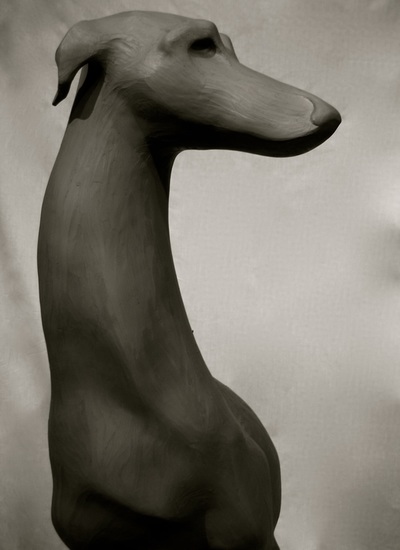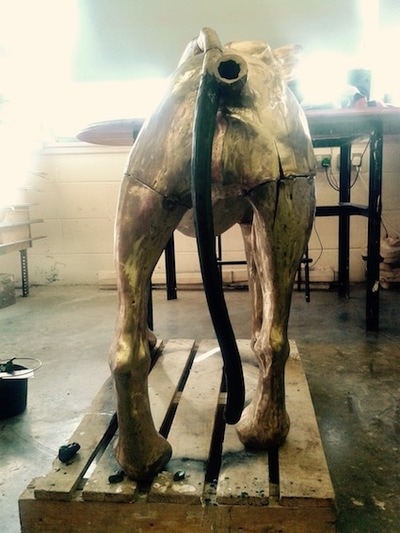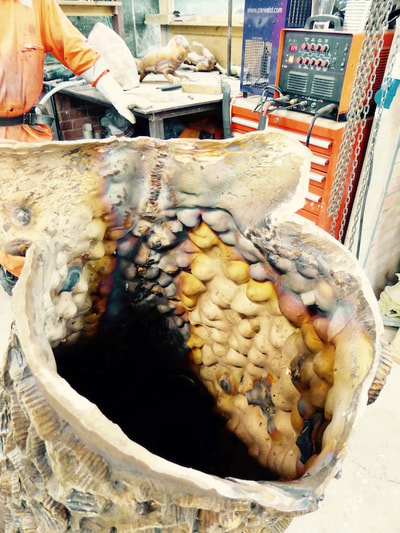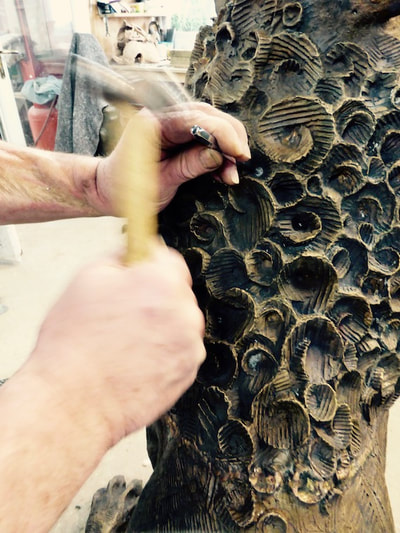work-in-progress
|
Bee Speaker
This unfinished sculpture illustrates my working process. In this case, I am working with paper pulp and corrugated cardboard with honey comb and beeswax over a metal armature. Once complete, the sculpture is cast in bronze and precious metal. Though the form of this piece of sculpture is still in progress, the idea is fully formed. Bees and their declining numbers are currently part of our collective consciousness. Our own future and theirs are intertwined. Bees have been a symbol of rebirth since at least the Bronze Age, retold in the Old Testament story of Samson and the Lion. It is a violent love story between a headstrong young warrior and an unsuitable girl. On Samson’s journey to claim his bride a lion attacks him. In his passion, Samson kills the lion with his bare hands. On his return he comes across the lion’s corpse to find it has been colonised by a swarm of bees and the carcass is filled with honey. It has become the cusp between death and rebirth, destruction and recreation. The imagery from this story is part of our popular culture through Britain’s oldest and potentially strangest logo, the Tate and Lyle golden syrup tins, with the biblical strap line ‘out of the strong comes forth sweetness’. Bees have also long been associated with love and honeymoon. For those of us not beekeepers, the art of apiary seems like alchemy and its practises can be strangely poetic, like the Queen cage that protects and imprisons the new matriarch by a sliver of sugared paper. Beekeeping customs are ancient and resonant, the bee speaker whispers news of births and marriages to the hive, and the bees must always be told when their keeper dies. My sculpture of the lion and the bee shows a moment of transformation, from earth bound body to air borne being. |
|
TREE SPEAKER, a calendar of trees
This project was commissioned by Penelope Salmon 'Birth Tree Cards'. The brief was to illustrate and interpret the Irish Tree Ogham, producing 13 linocut prints representing 13 lunar months, with the aim to develop interest, attachment and investment in British trees through these images. The ancient Irish tradition of the Tree Ogham brings together indigenous tree lore with alphabetic and calendric systems and poetic and divinatory practices. Each of my linocut prints represents a letter of the ogham alphabet through an individual tree in its corresponding lunar month. Each one is named after a line from the ‘The Song of Amergin’ (an Irish bardic incantation) and explores mythological, practical and botanical associations. Each one is drawn in the landscape surrounding my studio, in the water meadows, ancient woodland and open downland. |
For example, 'I am the Stag of Seven Tines' is the first line of the Song of Amergin and represents the first consonant of the alphabet (B), the birch tree (beth) and the first lunar month of the year. My linocut print shows a roebuck in a dense thicket of birch trees, drawn in January when the low sun casts deep shadows and brilliant shafts of light through the slender trunks and the roe deer, still in their dark winter coats, are clustered into small family groups. Botanically, the birch is a pioneer species; it is among the first to colonise clear ground and in this sense is the first tree in the forest. After the last ice age the British Isles would have been covered in great swathes of birch forest. Thus the birch represents new beginnings and has been long associated with inception, birth and regeneration, for instance traditionally a baby's cradle should be made of birch wood. Uniquely among deer species, Roe deer have an unusual inception mechanism in their breeding cycle, embryonic diapause; this means that their rutting season occurs in the summer but the resulting fertilised egg is suspended in a state of dormancy and does not implant and begin to grow until January. The roebuck casts and regrows his antlers during the winter. Antlers of all species have long been prized for their practical (tools), aesthetic (ornamentation) and symbolic (ritual) value and unusual antler formations are a source of fascination. Frequently caused by battle injury, antler deformations can identify an older and more assertive male. In maturity, a roebuck has up to 6 points but in exceptional circumstances can grow more, in this case a brow tine on the burr, to make a total 7 tines.





















